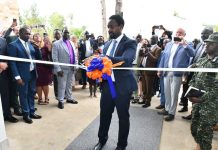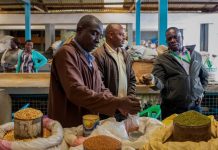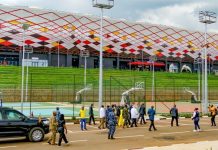Faridah N Kulumba
Africa-Press – Uganda. TotalEnergies on 19th July this year started drilling operations in Uganda a few days after the Human Rights Watch (HRW) released a report that dubbed “Our Trust is Broken: Loss of Land and Livelihoods for Oil Development in Uganda.”
The French oil giant company’s drilling operations began at one of the wells in the Murchison Falls National Park. Drilling Engineers at Jobi-Rii well confirmed that they had reached the hydrocarbons not so far deep as had been expected. Unlike KingFisher where wells are 4-7 kilometers, drillers at Tilenga found oil less than two kilometers deep.
According to Alex Nyombi, the Director of Development and Production at the Petroleum Authority Of Uganda (PAU), drilling oil in Tilenga is likely to be cheaper than KingFisher operated by China National Offshore Oil Corporation or CNOOC Group.
Mr. Nyombi explained that the King Fisher wells are quite deep. Some of the wells go up to seven kilometers. This means one Tilenga well will cost relatively much lower than a single well in KingFisher.
On 10th July this year, Human Rights Watch released a report that was published by the New York-based non-profit with the concerns that the world’s longest-planned East African Crude Oil Pipeline (EACOP) meant to export crude from Uganda to international markets has “devastated” the lives of thousands of people.
The HRW report said that thousands of people who are staying in the areas where the crude oil pipeline is intended to pass have experienced delayed or inadequate compensation for their land.
The rights group added that the EACOP project, in which TotalEnergies has a 62 percent stake, is a disaster for the planet as it will add emissions that exacerbate climate change.
Drilling operations
The Petroleum Authority Of Uganda engineers in charge of the drilling operations at the Jobi-Rii well pad said after the successful drilling exercise, the drillers at the site were preparing the casings to make the wells ready for oil and gas extraction from the ground.
About 18 wells will be established at Jobi-Rii. Totalenergies plans to drill over 426 wells, which will include (200 water injector wells and 196 oil producer wells on 31 well-pads located in Nwoya and Buliisa districts. The SINOPEC 1503 at Jobi-Rii is a state-of-the-art automated rig known as the “walking rig” that walks on hydraulic feet between drill sites. According to the engineers at the site, its portability makes it easy to drill many wells from the same drill pad.
The rig stands at about sixty-meter high in the middle of the national. It is painted with beige color to resemble the surrounding Savannah grasslands. Unlike in other oil-producing countries, the well pads in Tilenga and King Fishers projects will not have the noise-making pump that is commonly used to extract oil commonly known as a nodding donkey.
There had been concerns that old-fashioned nodding donkey technology would be too noisy and possibly force wildlife to migrate. The TotalEnergies rigs have been fitted with technologies to minimize the noise in the national park and its surroundings.
PAU maintains that the latest technological innovations are being used to ensure Uganda’s oil projects generate the lowest carbon footprint possible, ensuring that together the projects have been classified as falling within the category of ‘low emission.
The carbon dioxide equivalent emission per barrel of oil produced will be in the range of 20-45 kgCO2e. This is well below the global average of 70-100 kgCO2e.
In 2012, TotalEnergies E&P Uganda promised to use environmentally friendly technology to develop oil resources in sensitive areas. It also promised to limit the number of well pads to ensure that oil activities limit a footprint on an ecologically sensitive area like the Murchison.
The PAU director explained that drilling of 14-18 on a single well pad in the case of Uganda is because the oil in the Albertine does not flow easily. According to him, these
reservoirs are extensive and the oil takes a long time to move from one point to another.
Production from the Tilenga oil development project is expected to begin in 2025 and is forecast to peak in 2028, at approximately 190,000 barrels per day (bpd) of crude oil and condensate. Based on economic assumptions, the production will continue until the field reaches its economic limit in 2057.
The drilling at Tilenga comes almost six months after President Museveni launched a similar exercise at King Fisher operated by CNOOC. Thirty-one wells will be drilled at the KingFisher project located at the shores of Lake Albert in the Kikuube district.
The Kingfisher field, operated by the state-owned China National Offshore Oil Corporation (CNOOC), is expected to produce 40,000 barrels of oil per day at its peak.
The KingFisher and Tilenga projects are yet to construct the Central Processing Facilities(CPF) to purify the crude once pulled out of the ground. The engineers started the process of drilling the wells for production.
The field is being developed by a partnership of oil and gas companies: TotalEnergies E&P, (56.67 percent), China National Offshore Oil (CNOOC), (28.33 percent), and Uganda National Oil Company (15 percent). CNOOC Uganda, a subsidiary of CNOOC, serves as the operator of the field.
The rights groups still protest TotalEnergies’ development of an oil field in a natural park. But the French giant oil company defended itself by saying that most of the Tilenga project wells will not be developed in the Murchison Falls Park.
TotalEnergies argue that while current permits would have allowed drilling over an area representing 10 percent of the park’s surface, the company has intentionally restricted development to less than 0.05 percent of the surface area (i.e. a footprint 200 times smaller). The wells will be limited to 10 locations and will be as compact as possible. They were designed to limit visual impact, particularly through the development of vegetated banks.
The company also said that it is investing alongside the authorities in an effort to better manage the park which is currently partly affected by poaching.
For More News And Analysis About Uganda Follow Africa-Press






